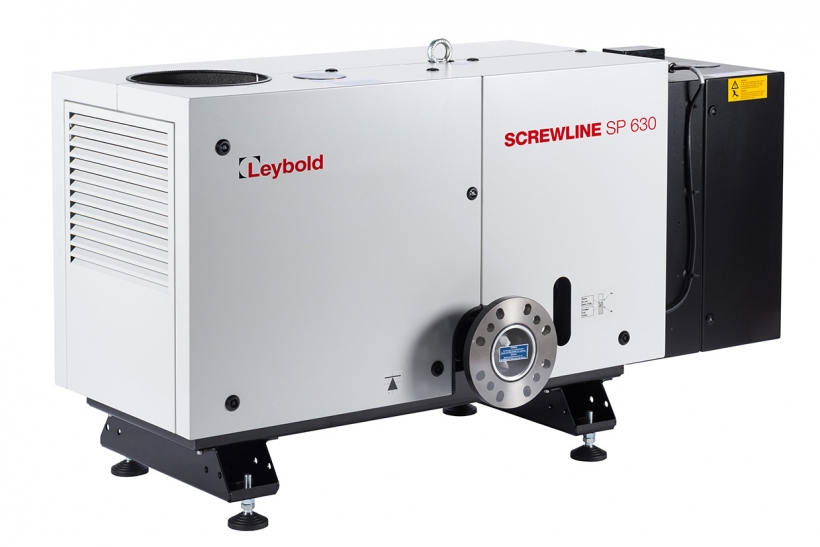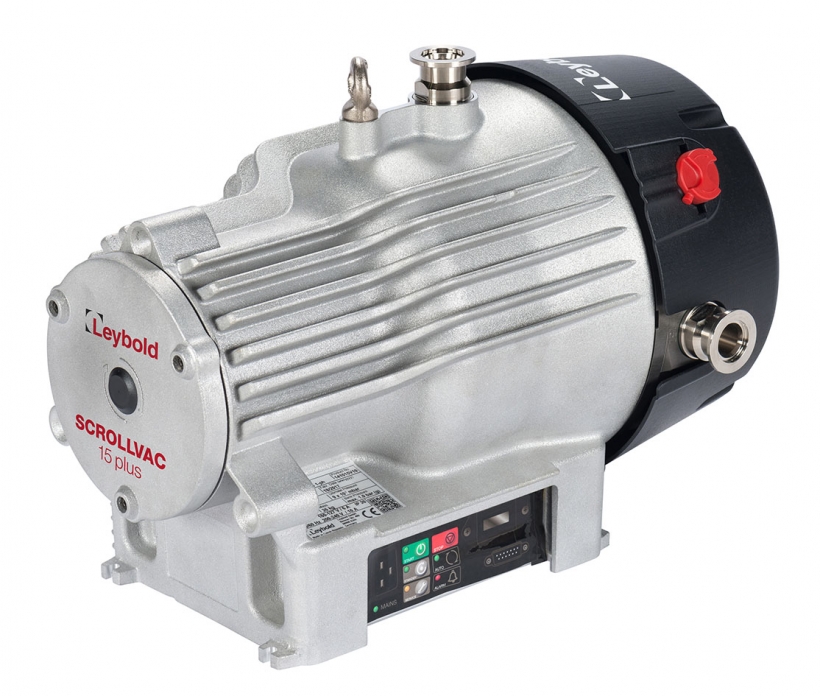
The need for energy-efficient, sustainable processes is increasing especially with regard to the frictions caused by high energy prices, increasing global warming and scarce resources. These requirements also have a direct impact on vacuum systems, which are an elementary component in heat treatment plants and metallurgical processes. Leybold offers a wide range of vacuum solutions especially for this requirement profile.
State-of-the-art mechanical vacuum pump systems are powerful tools for efficient operation. They have a robust design that enables the pumps to withstand harsh production environments. No matter what type of vacuum systems are operated: Innovative vacuum solutions reduce operating costs and CO2 emissions while providing complete process control.

DRYVAC 200/300
Pump systems consisting of dry-compressing screw vacuum pumps of the DRYVAC type combined with RUVAC WH Roots pumps have proven themselves in use on secondary metallurgical VD, VOD or RH degassers. By using these standard pumps, even the highest demands on pumping speed can be met with the greatest reliability at competitive prices.
To achieve high vacuum in VIM or VAR installations, Leybold offers the most modern oil booster pumps available on the market, which in combination with dry compressing DRYVAC screw pumps and RUVAC Roots pumps ensure maximum system availability at lowest operating costs.

SOGEVAC NEO D
Leybold has an even larger product portfolio for use in vacuum heat treatment furnaces: Oil-sealed SOGEVAC rotary vane pumps have proven themselves in clean processes such as hardening or tempering. For more demanding processes such as soldering, sintering or carburizing, dry-compressing screw pumps are also available. Depending on size and process, pumps of the DRYVAC, SCREWLINE or VARODRY series can be used.
From single pumps to complex steel degassing systems: As the components for vacuum systems are manufactured in large quantities, the delivery time is short, they are cost effective and provide proven high quality, thus contributing to the success of the customer.
SOGEVAC NEO D - the emission-free rotary vane pump
Nowadays, modern vacuum technology must convince its users with emission-free, smooth running and sustainability. With these requirements in mind, Leybold has developed the compact SOGEVAC NEO D, an innovative 2-stage vacuum pump with integrated oil mist separator on the exhaust side. The working environment remains clean and free of oil mist during pumping. Continuous operation is possible without an external filter at any inlet pressure.
The robust SOGEVAC NEO D is optimized for applications requiring a pumping speed in the range of 1x10-2 to 1mbar; perfect for small heat treatment furnaces or as a holding pump for diffusion pumps. The SOGEVAC NEO D offers a stable process vacuum but is less expensive than conventional alternatives and saves up to ten percent energy due to its significantly smaller rotating mass. Additional energy savings can be achieved by operating the pump by means of speed control with a frequency converter.
DRYVAC DV 200 and DV 300 - the innovative dry pumps
The dry-compressing screw vacuum pumps are designed for modern, intelligent production. They offer maximum energy efficiency, durability and future-proof network integration. Due to the optimized rotor geometry and the innovative motor design with efficiency class IE3, these pump types minimize power consumption and CO2 emissions. The bottom line is that DRYVAC pumps are cheaper and more environmentally friendly than comparable models.
The new compact DRYVAC models DV 200 and DV 300 are designed for harsh industrial applications, just as the larger pumps of the same pump series. They offer a long service life, even under demanding conditions with high humidity, dust or other process particles. DRYVAC pumps also require minimal maintenance.

VARODRY - the 100% oil-free, dry-compressing screw pump
The 100% oil-free, dry-compressing and air-cooled VARODRY screw pump guarantees the required operating pressure and a short cycle time, especially in demanding processes. Thanks to its compact design and reduction to the essentials, the vacuum pump can be easily integrated into new or existing systems. Due to the integrated silencer, it is quiet and has a pleasant operational noise.
The air-cooled VARODRY is absolutely dry and clean. This prevents particle or oil migrations into the vacuum chamber or the environment. A further process advantage is their resilience and efficiency. It can be operated continuously at any inlet pressure and is completely resistant to regular shock ventilation. Therefore, any number of cycles can be run without overloading. VARODRY pumps ensures uninterrupted operation without system downtimes. This qualifies it as the ideal vacuum pump for heat treatment applications and metallurgical processes.

SCREWLINE - dry screw pump for extremely dirty applications
In demanding applications such as sintering or carburizing, dry-compressing screw pumps are preferred as backing pumps. They are more efficient and reliable than oil-sealed pumps. Especially the SCREWLINE pumps have proven themselves in extremely dirty applications. Their main advantage: The pump chamber of this pump family can easily be cleaned by the customer on site, for example during process pauses by means of flushing.

SCROLLVAC - low power consumption, high pumping speed
With the air-cooled, oil-free SCROLLVAC plus, Leybold offers an uncomplicated, reliable backing pump. Its properties predestine it for a wide range of demanding applications, such as laboratory vacuum furnaces. This is also due to the low power consumption of the backing pump combined with high pumping speed. In addition, the SCROLLVAC plus, with its lightweight, compact design, takes up very little space. This enables integration into new and existing vacuum systems.
Its functional and design features simplify daily handling of the backing pump. For example, the hermetic sealing of the rotating parts of the pump chamber reduces the risk of contamination. By dispensing with shaft seals that are susceptible to wear, developers have achieved higher integral tightness.

DIP - DIJ - OB - Oil-jet steam pumps and systems for high-vacuum processes
Oil steam jet pumps and systems are characterized by the highest pumping speeds in metallurgical industrial high-vacuum processes. These pumps are robust continuous-running pumps and have proven themselves in steel production processes such as VIM and VAR, or in high-vacuum industrial furnaces. The pumping effect of these ejector pumps is created through the diffusion of the gases that are pumped into the vapor jet. Compared to other high vacuum pumps, the pumping speed compared to the surface area is very high.
Contact Details
Related Glossary Terms
- backing
backing
1. Flexible portion of a bandsaw blade. 2. Support material behind the cutting edge of a tool. 3. Base material for coated abrasives.
- carburizing
carburizing
Absorption and diffusion of carbon into solid ferrous alloys by heating, to a temperature above the transformation range, in contact with a suitable carbonaceous material. A form of casehardening that produces a carbon gradient extending inward from the surface, enabling the surface layer to be hardened either by quenching directly from the carburizing temperature or by cooling to room temperature, then reaustenitizing and quenching.
- diffusion
diffusion
1. Spreading of a constituent in a gas, liquid or solid, tending to make the composition of all parts uniform. 2. Spontaneous movement of atoms or molecules to new sites within a material.
- hardening
hardening
Process of increasing the surface hardness of a part. It is accomplished by heating a piece of steel to a temperature within or above its critical range and then cooling (or quenching) it rapidly. In any heat-treatment operation, the rate of heating is important. Heat flows from the exterior to the interior of steel at a definite rate. If the steel is heated too quickly, the outside becomes hotter than the inside and the desired uniform structure cannot be obtained. If a piece is irregular in shape, a slow heating rate is essential to prevent warping and cracking. The heavier the section, the longer the heating time must be to achieve uniform results. Even after the correct temperature has been reached, the piece should be held at the temperature for a sufficient period of time to permit its thickest section to attain a uniform temperature. See workhardening.
- process control
process control
Method of monitoring a process. Relates to electronic hardware and instrumentation used in automated process control. See in-process gaging, inspection; SPC, statistical process control.
- sintering
sintering
Bonding of adjacent surfaces in a mass of particles by molecular or atomic attraction on heating at high temperatures below the melting temperature of any constituent in the material. Sintering strengthens and increases the density of a powder mass and recrystallizes powder metals.
- tempering
tempering
1. In heat-treatment, reheating hardened steel or hardened cast iron to a given temperature below the eutectoid temperature to decrease hardness and increase toughness. The process also is sometimes applied to normalized steel. 2. In nonferrous alloys and in some ferrous alloys (steels that cannot be hardened by heat-treatment), the hardness and strength produced by mechanical or thermal treatment, or both, and characterized by a certain structure, mechanical properties or reduction in area during cold working.







